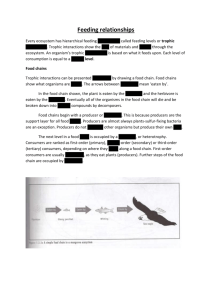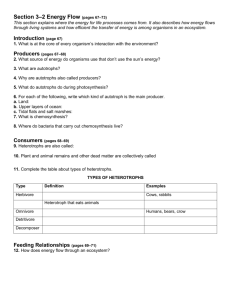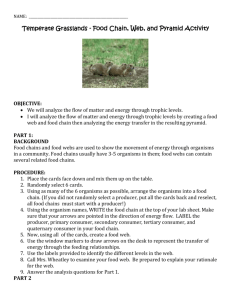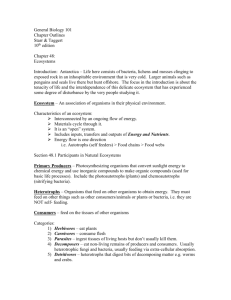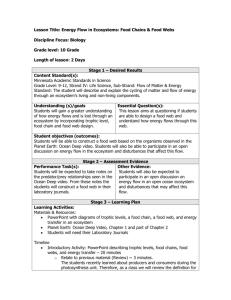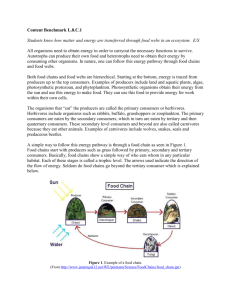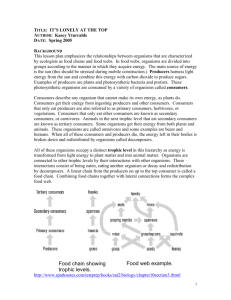Name: Core:
advertisement
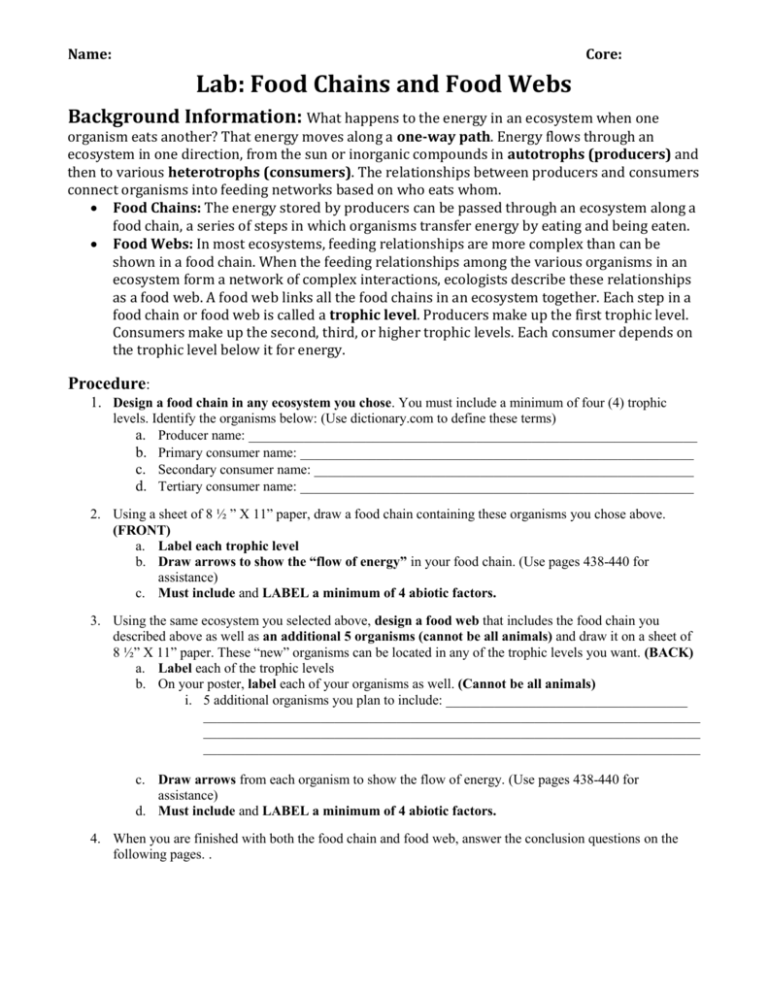
Name: Core: Lab: Food Chains and Food Webs Background Information: What happens to the energy in an ecosystem when one organism eats another? That energy moves along a one-way path. Energy flows through an ecosystem in one direction, from the sun or inorganic compounds in autotrophs (producers) and then to various heterotrophs (consumers). The relationships between producers and consumers connect organisms into feeding networks based on who eats whom. Food Chains: The energy stored by producers can be passed through an ecosystem along a food chain, a series of steps in which organisms transfer energy by eating and being eaten. Food Webs: In most ecosystems, feeding relationships are more complex than can be shown in a food chain. When the feeding relationships among the various organisms in an ecosystem form a network of complex interactions, ecologists describe these relationships as a food web. A food web links all the food chains in an ecosystem together. Each step in a food chain or food web is called a trophic level. Producers make up the first trophic level. Consumers make up the second, third, or higher trophic levels. Each consumer depends on the trophic level below it for energy. Procedure: 1. Design a food chain in any ecosystem you chose. You must include a minimum of four (4) trophic levels. Identify the organisms below: (Use dictionary.com to define these terms) a. Producer name: _________________________________________________________________ b. Primary consumer name: _________________________________________________________ c. Secondary consumer name: _______________________________________________________ d. Tertiary consumer name: _________________________________________________________ 2. Using a sheet of 8 ½ ” X 11” paper, draw a food chain containing these organisms you chose above. (FRONT) a. Label each trophic level b. Draw arrows to show the “flow of energy” in your food chain. (Use pages 438-440 for assistance) c. Must include and LABEL a minimum of 4 abiotic factors. 3. Using the same ecosystem you selected above, design a food web that includes the food chain you described above as well as an additional 5 organisms (cannot be all animals) and draw it on a sheet of 8 ½” X 11” paper. These “new” organisms can be located in any of the trophic levels you want. (BACK) a. Label each of the trophic levels b. On your poster, label each of your organisms as well. (Cannot be all animals) i. 5 additional organisms you plan to include: ___________________________________ ________________________________________________________________________ ________________________________________________________________________ ________________________________________________________________________ c. Draw arrows from each organism to show the flow of energy. (Use pages 438-440 for assistance) d. Must include and LABEL a minimum of 4 abiotic factors. 4. When you are finished with both the food chain and food web, answer the conclusion questions on the following pages. . Name: Core: Lab: Food Chains and Food Webs Conclusion Questions: Directions: All answers need to be written in complete sentences in order to receive your full points. 1. What kind of ecosystem (aquatic or Terrestrial or Both) did you use in your example? Explain how you know it is this type of ecosystem. _________________________________________________________ _____________________________________________________________________________________ _____________________________________________________________________________________ _____________________________________________________________________________________ _____________________________________________________________________________________ 2. What kind of biome did you choose for your poster? Explain 3 traits that are unique to this biome. ______ _____________________________________________________________________________________ _____________________________________________________________________________________ _____________________________________________________________________________________ _____________________________________________________________________________________ _____________________________________________________________________________________ 3. What is a trophic level? _________________________________________________________________ _____________________________________________________________________________________ _____________________________________________________________________________________ 4. What is the ultimate source of energy for most organisms on our planet? __________________________ _____________________________________________________________________________________ 5. Explain the difference between a food chain and a food web? ___________________________________ _____________________________________________________________________________________ _____________________________________________________________________________________ _____________________________________________________________________________________ _____________________________________________________________________________________ _____________________________________________________________________________________ _____________________________________________________________________________________ 6. What is a decomposer? Give 3 examples of decomposers that exist on Earth today. __________________ _____________________________________________________________________________________ _____________________________________________________________________________________ o 3 Examples: 1. _________________________________ 2. _________________________________ 3. _________________________________ 7. Identify a decomposer you could have added to your food chain and food web. _____________________ _____________________________________________________________________________________ _____________________________________________________________________________________ 8. Identify a scavenger you could have added to your food chain and food web. _______________________ _____________________________________________________________________________________ _____________________________________________________________________________________ Name: Core: Lab: Food Chains and Food Webs 9. Define the following terms and then provide 1 example of an organism for each: a. Herbivore: ____________________________________________________________________ ______________________________________________________________________________ - 1 Example: _________________________________________ b. Carnivore: ____________________________________________________________________ ______________________________________________________________________________ - 1 Example: _________________________________________ c. Omnivore: ____________________________________________________________________ ______________________________________________________________________________ - 1 Example: _________________________________________ d. Decomposer: __________________________________________________________________ ______________________________________________________________________________ - 1 Example: _________________________________________ e. Scavenger: ____________________________________________________________________ ______________________________________________________________________________ - 1 Example: _________________________________________ f. Autotroph: ____________________________________________________________________ ______________________________________________________________________________ - 1 Example: _________________________________________ g. Heterotroph: __________________________________________________________________ ______________________________________________________________________________ - 1 Example: _________________________________________
